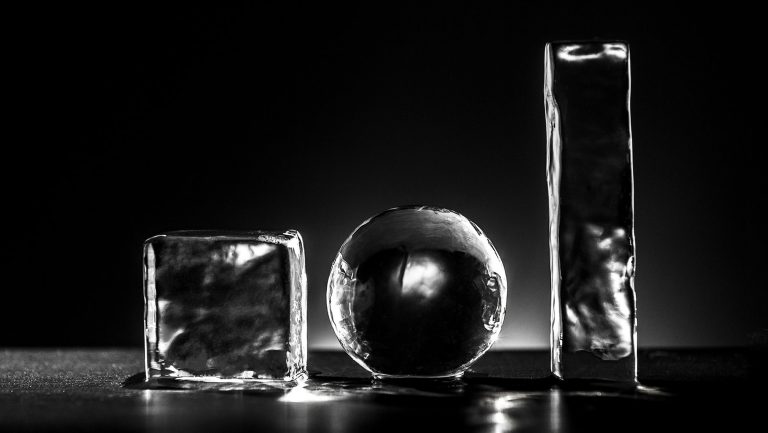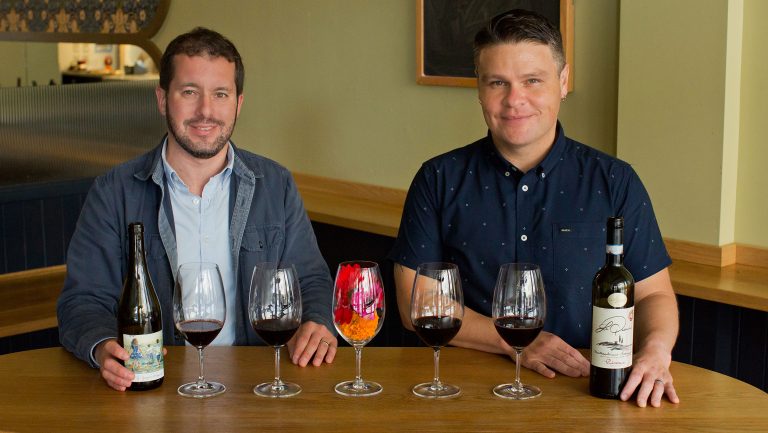Extra-large crystal-clear two-inch-square ice cubes don’t just pop out of a machine: At least for now, the big cubes and Collins spears preferred by top bars across the U.S. are cut down from sculpture-sized blocks using a variety of power and hand tools. While some bars take control of the entire process, from block making to cube cutting, in-house, a new wave of outside big-ice providers are reinventing the game.
The most common process by which big cubes are produced begins in an ice sculpture machine that produces a 300-pound block of clear ice. Currently, the most popular machine is made by Clinebell and costs $5,500 for the U.S. version, though other machines are on the market. It produces a block 20 inches by 40 inches by 10 inches thick. The ice is removed with a hoist, cut down into smaller slabs (often with an electric chainsaw), and then cut into cubes, spears, and other shapes (usually with a band saw).
The first bar credited with doing this in-house is Weather Up in New York City, and one of the bar’s former bartenders, Richard Boccato, went on to found Hundredweight Ice in 2011 to cut and deliver ice to other bars in town. Since then, craft-ice-delivery businesses have popped up in just about every major city to provide big cubes to small cocktail bars.

Don’t miss the latest drinks industry news and insights. Sign up for our award-winning newsletters and get insider intel, resources, and trends delivered to your inbox every week.
The most popular ice shapes sold are two-inch-square cubes to fit Old Fashioned glasses, and roughly 1.25-inch by 6-inch spears to fit Collins glasses, but various providers also sell punch blocks, ice spheres, and other shapes. Recently, several specialty ice providers, including The Ice Doctor in Gainesville, Florida, have offered individualized customization, cutting ice sized to each bar’s specific glassware.
Not all ice providers are ice producers: Some don’t own Clinebell machines but instead have the sculpture-sized blocks delivered to them. In San Francisco, a block, including delivery, costs about $140 and can produce anywhere from 450 to more than 800 two-inch cubes, depending on where the cutting is done and the tools used. Fat Ice in Austin, Texas, doesn’t own its ice machines or sell directly to bar or retail accounts; rather, it sells to distributors. Owner Javier Flores says this allows him to focus his attention on cutting and packaging.
“Producing it is nice, but sales need to happen as well,” Flores says. “This is why I signed a distribution deal with Spec’s in Texas, since they have sales reps across the state who can all help push my product.”
He says that retail 6-packs of 1.8-inch cubes sell for $7.99 in 48 Spec’s retail stores across Texas.
Minnesota Pure & Clear Ice sells ice to bars and leases their accounts freezers in which to store it for free, but has also made a large push into the retail space. They ship direct worldwide through their website, and can deliver via Amazon Prime Now so that anyone in the local area can get big clear ice cubes delivered within a two-hour window. Prices on the site start at $1 per two-inch cube and go as low as 78 cents each for large orders, with bulk/bar pricing available as well.
Miami’s Mixology Ice is making an even larger push both to sell craft cocktail ice nationally and to increase retail sales for the home cocktail market. The company already provides big ice to many top bars in Miami. Recently, they drove thousands of pounds of ice to the Tales of the Cocktail convention in New Orleans, and they’re already selling ice in other states, including New York, and Washington D.C., despite the long drives from Florida.

Now owner Carlos Leal has created packaging to hold twelve two-inch by two-inch cubes partitioned in such a way that they won’t stick together if they start to melt and are refrozen. These are for sale in a few stores in Miami and New York (retailing at $10–$12 per twelve-pack) so far, with plans to expand to Texas and California soon.
Some entrepreneurs are designing and building new ice machines that are better targeted to the cocktail ice market segment, closing the gap between the 300-pound blocks that sculpture manufacturers produce and the two-inch cubes that bartenders want. “Using our patented machine that we designed during our senior year of college, we are able to produce our cubes at a faster and more competitive pricing rate than anyone else in the market,” says Robbie Harrell, CEO of Minnesota Pure & Clear Ice. His company has created 2.5-inch puck-shaped ice with their machine to fit a particular glass.
“The 2.5-inch cylinder was designed to fit perfectly into a Libbey 1660SR glass that was being used by one of our clients,” Harrell says. “It has now become one of our best-selling products.”
Cameron Bogue, the Vancouver-based founder of Bartenders Ice, has just launched a machine that makes four 50-pound blocks of ice every three to four days rather than one large block. The machine will be offered for sale at a price meant to be competitive with the Clinebell. It works in essentially the same way as other block makers, but the smaller-sized blocks mean that no hoists or power tools are necessary to break down the blocks into smaller cubes: The work can be done using only a band saw or hand tools.
We should expect to see even more providers, and more new products being launched, in the coming years. The business landscape for big ice is changing rapidly, and this should ultimately provide more clear-ice options at lower prices for both bars and home consumers.

Dispatch
Sign up for our award-winning newsletter
Don’t miss the latest drinks industry news and insights—delivered to your inbox every week.
Camper English is an international cocktails and spirits writer, speaker, and consultant, with a focus on the science of booze and big clear ice. His work has appeared in Popular Science, Cook’s Science, Whisky Advocate, Saveur, Details, the San Francisco Chronicle, and many other publications.







